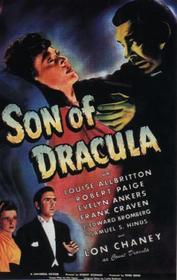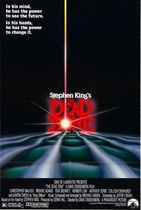Our editor-in-chief Nate Yapp is proud to have contributed to the new book Hidden Horror: A Celebration of 101 Underrated and Overlooked Fright Flicks, edited by Aaron Christensen. Another contributors include Anthony Timpone, B.J. Colangelo, Dave Alexander, Classic-Horror.com's own Robert C. Ring and John W. Bowen. Pick up a copy today from Amazon.com!
Son of Dracula (1943)
"Miscast" is a nasty term. It suggests that the actor or actress that it is applied to would never be able to pull off their given role, even under the best possible circumstances. Some irreparable mistake was made at an early stage of production and the film will be forever marred by the poor judgment of some myopic decision-maker. Such is the case with Lon Chaney, Jr. as Count Dracula in Universal's misleadingly titled Son of Dracula. Chaney's inability to pull off the Old World nobility required of the part has dogged the film's reputation since its release. This is a shame, really, since the rest of this mature, atmospheric chiller works quite well.
Katherine Caldwell (Louise Allbritton) is throwing a party at her Louisiana manse, Dark Oaks, to celebrate the arrival of a mysterious acquaintance she made while traveling in Eastern Europe. The guest of honor goes by the name Count Alucard, and his eventual appearance seems to change a great many things. Katherine breaks of her engagement to long-suffering Frank (Robert Paige) and marries the mysterious Count, who never seems to be around during the day. When Frank appears to kill Katherine while confronting her pale new husband, it's up to the town doctor (Frank Craven) to prove that the key to this mystery may be as simple as spelling backwards.
Location is paramount in Gothic horror, and writers Curt Siodmak (story) and Eric Wise (screenplay) made wise choice in choosing Louisiana as Alucard/Dracula's berth in the New World. The tangled vines and muddied waters of the bayou are as sinister as any desolate mountain road in Transylvania. The consistent overgrowth and dank air give a sense of corruption -- evil encroaching on the simple lives of an American small town. By the end of the film, Dark Oaks looms with threatening shadows, much in the way of Carfax Abbey. Unsurprisingly, director Robert Siodmak (Curt's brother) went on to helm several minor noir classics, including The Spiral Staircase.
Siodmak adds to the atmosphere by presenting his villain in a otherworldly manner. Despite Chaney's inert performance, Son of Dracula really makes the most of its monster. Musically, Dracula's first appearances are marked by eerie, discordant organ playing -- a far cry from the snippets of classical compositions that marked earlier Universal releases (Swan Lake, anyone?). The weird oscillations add a level of discomfort -- if such a foreign sound could intrude on a traditional Universal horror film, what other surprises await? Likewise, there is a later scene that crawls with creepy imagery, where Dracula's coffin rises from beneath the muck of the swamp, and then the vampire himself glides toward the waiting Katherine, floating over the waters.
Son of Dracula's substance is an easy match for its style, incorporating ideas that wouldn't be repeated again for a number of years. For instance, Katherine willingly and consciously desires to join the ranks of the undead, and yet she remains a sympathetic character with complex, human motives. She is never portrayed as explicitly evil, and she becomes one of Hollywood's first true advocates for vampirism (both Bela Lugosi in Dracula '31 and Gloria Holden in Dracula's Daughter express a desire to divest themselves of the immortal coil). Unfortunately, there is also a definite sense that this plot thread is not at its full potential, possibly due to studio interference. However, it remains refreshing that we get to see any of it, and we cannot expect miracles from the strong code of "moral decency" that plagued so many films of the era.
Frank, the male hero, provide more complexity to the storyline. He is neither a bewildered milquetoast (a la David Manners) or a rugged doer of deeds. Instead, he is just a man -- initially quite secure in both his position and his masculinity. That is, until another male comes into the picture and proves himself to be stronger, more alluring, and altogether Frank's superior. Dracula steals Frank's fiancée, his presupposed mastery of Dark Oaks, and his peace of mind. Frank watches every bit of his life stripped away from him by the vampire, and what's worse, Dracula barely notices he's there. Deprived of all the things that constitute his position of masculine authority, Frank first tries to even the odds at the barrel of a gun. His first act of territorial aggression against his usurper fells the very woman he is trying to win back, and he completely unhinges. It is only later when his true ownership of Katherine's heart is confirmed that he begins to pull himself together (although he's never entirely lucid again).
If Son of Dracula suffers for anything (other than poor casting), it is the fact that the plot and character complexities reduce the potential for terror, and Siodmak never really compensates. The film is really more of a spooky melodrama than an actual scarefest. Then again, what's wrong with that, really?









This is one of my favourite
This is one of my favourite films. I agree about Chaney, but I think he was still quite restrained and delicately menacing in a few scenes. If he really had been the son of Dracula, it would've been better, because it would have allowed his performance to be quite different from Lugosi's. The accent though is a big problem- the little boy Alucard attacks says a foreign man attacked him, while Chaney's voice is so wonderfully American!
Review: Son of Dracula
Miscast No! I strongly disagree with Mr. Yap's comment about Lon Chany, Jr. being miscasted in the horror flick The Son of Dracula. I think he has some preconceived idea how Dracular (in this case son of Dracular) should be portrayed and in doing so comparing Chaney with Bela Logosi. These two actors are different than night and day, there is no comparison. I thought Chaney was very affective and brought a unnerving presence in the movie.
There were several unforgettable scenes in this movie. Dracula's coffin rises from beneath the muck of the swamp for example. This movie is a classic portrayed by a classic star Lon Chaney, Jr. Lon Chaney's character acting made this movie work. Good atmosphere in the location scenes were very affective and well thought out.
I rate a movie a classic when there are scenes in the movie that you will forever remember. Son of Dracular successfully does this and in my mind this movie is a classic. Yes Mr. Yap miscast is a nasty term, and in the case of Mr. Chaney's portrayal of "The Son of Dracula" miscast doen't hold water..
Robert Paige, my cousin told
Robert Paige, my cousin told me he balked at having a bat crawl over him in the cemetery scene, so they dyed a rat black and attached plastic wings.Fooled me. Alan Curtis was originally slated to play Frank Stanley, but he took ill. In the book, "Universal Horrors", Paige gets a highly laudable review for his work in this film.